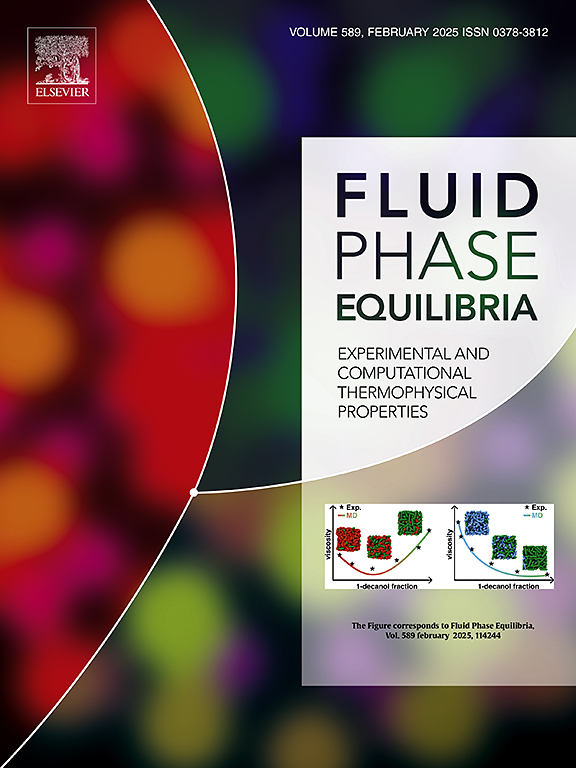Determining state points through the radial distribution function of Yukawa fluids at equilibrium
IF 2.8
3区 工程技术
Q3 CHEMISTRY, PHYSICAL
引用次数: 0
Abstract
Based on our previous work [Fluid Phase Equilibria, 2023, 567, 113709], we here use the radial distribution function (RDF) to determine the state points (density and temperature) of a fluid under the Yukawa potential at equilibrium. The reduced density and reduced temperature are defined as and , respectively. Through the Molecular Dynamics (MD) simulations, we obtain equilibrium configurations and use these data for building models via two methods. The first method establishes two empirical correlations for each potential considered, one between the heights of the first peaks of the RDFs and state points, as well as the other between the displacements of the first peaks of the RDFs and state points. Through these empirical correlations, we can determine the state points of new Yukawa fluid systems with 100% accuracy. The second method utilizes artificial neural network models to predict state points from the heights and displacements of the first peaks of the RDFs, achieving 100% accuracy when the predicted results are rounded to one decimal place. The success of these methods again demonstrates the feasibility of determining state points solely based on equilibrium configurations, is an extension from the Lennard-Jones fluids to the Yukawa potential related fluids.
通过平衡状态下汤川流体的径向分布函数确定状态点
基于我们之前的工作[Fluid Phase Equilibria, 2023, 567, 113709],我们在此使用径向分布函数(RDF)来确定流体在尤卡娃势平衡下的状态点(密度和温度)。还原密度和还原温度分别定义为 ρ*=ρσ3 和 β*=1/T*=ϵ/kBT 。通过分子动力学(MD)模拟,我们获得了平衡构型,并利用这些数据通过两种方法建立模型。第一种方法是为所考虑的每种电位建立两种经验相关性,一种是 RDFs 的第一个峰的高度与状态点之间的相关性,另一种是 RDFs 的第一个峰的位移与状态点之间的相关性。通过这些经验相关性,我们可以 100% 准确地确定新汤川流体系统的状态点。第二种方法是利用人工神经网络模型,根据 RDF 第一个峰的高度和位移预测状态点,当预测结果四舍五入到小数点后一位时,准确率达到 100%。这些方法的成功再次证明了仅根据平衡构型确定状态点的可行性,这是从伦纳德-琼斯流体扩展到尤卡瓦势相关流体的一种方法。
本文章由计算机程序翻译,如有差异,请以英文原文为准。
求助全文
约1分钟内获得全文
求助全文
来源期刊

Fluid Phase Equilibria
工程技术-工程:化工
CiteScore
5.30
自引率
15.40%
发文量
223
审稿时长
53 days
期刊介绍:
Fluid Phase Equilibria publishes high-quality papers dealing with experimental, theoretical, and applied research related to equilibrium and transport properties of fluids, solids, and interfaces. Subjects of interest include physical/phase and chemical equilibria; equilibrium and nonequilibrium thermophysical properties; fundamental thermodynamic relations; and stability. The systems central to the journal include pure substances and mixtures of organic and inorganic materials, including polymers, biochemicals, and surfactants with sufficient characterization of composition and purity for the results to be reproduced. Alloys are of interest only when thermodynamic studies are included, purely material studies will not be considered. In all cases, authors are expected to provide physical or chemical interpretations of the results.
Experimental research can include measurements under all conditions of temperature, pressure, and composition, including critical and supercritical. Measurements are to be associated with systems and conditions of fundamental or applied interest, and may not be only a collection of routine data, such as physical property or solubility measurements at limited pressures and temperatures close to ambient, or surfactant studies focussed strictly on micellisation or micelle structure. Papers reporting common data must be accompanied by new physical insights and/or contemporary or new theory or techniques.
 求助内容:
求助内容: 应助结果提醒方式:
应助结果提醒方式:


